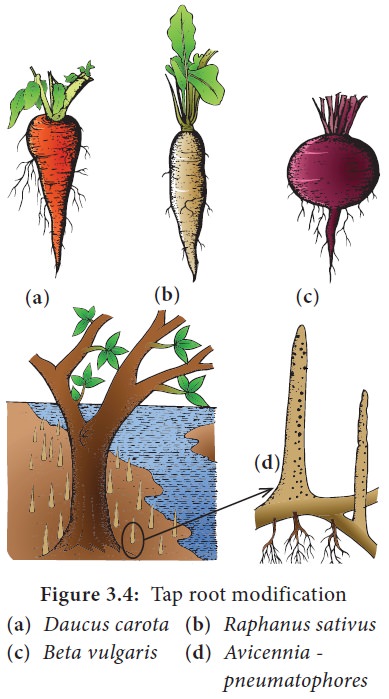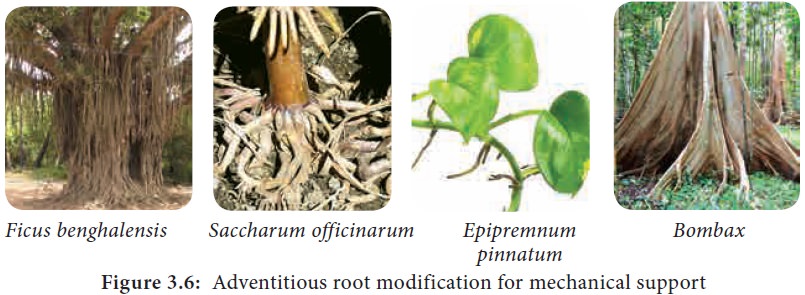Chapter: 11th Botany : Chapter 3 : Vegetative Morphology of Angiosperm
Modifications of root
I. Tap root modification
a. Storage roots
1. Conical Root
These are cone like, broad at the base and
gradually tapering towards the apex. Example: Daucus carota.
2. Fusiform root
These roots are swollen in the middle and tapering
towards both ends. Example: Raphanus
sativus
3. Napiform root
It is very broad and suddenly tapers like a tail at
the apex. Example: Beta vulgaris

b. Breathing root
![]()
![]()
![]()
Some mangrove plants like Avicennia, Rhizophora,
Bruguiera develop special kinds of roots (Negatively geotropic) for
respiration because the soil becomes saturated with water and aeration is very
poor. They have a large number of breathing pores or pneumatophores for
exchange of gases.
II. Adventitious root
modification
a. Storage roots
1. Tuberous root
These roots are swollen without any definite shape.
Tuberous roots are produced singly and not in clusters. Example: Ipomoea batatas.
2. Fasciculated root
These roots are in cluster from the base of the
stem Example: Dahlia, Asparagus, Ruellia.
3. Nodulose root
In this type of roots swelling occurs only near the
tips. Example: Maranta (arrow root) Curcuma amada (mango ginger), Curcuma longa (turmeric)

4. Moniliform or Beaded root
These roots swell at frequent intervals giving them
a beaded appearance. Example: Vitis,
Portulaca, Momordica, Basella (Indian
spinach).
5. Annulated root
These roots have a series of ring- like swelling on
their surface at regular intervals. Example: Psychotria (Ipecac)
b. Mechanical support
1. Prop (Pillar) root
These roots grow vertically downward from the lateral branches into the soil.
Example: Ficus
benghalensis (banyan tree), Indian rubber.

2. Stilt (Brace) root
These are thick roots growing obliquely from the
basal nodes of the main stem. These provide mechanical support.
Example: Saccharum
officinarum, Zeamays, Pandanus,
Rhizophora.
3. Climbing (clasping or clinging) roots
These roots are produced from the nodes of the stem
which attach themselves to the support and help in climbing. To ensure a
foothold on the support they secrete a sticky juice which dries up in air,
attaching the roots to the support. Example: Epipremnum pinnatum, Piper betel,
Ficus pumila.
4. Buttress root
In certain trees broad plank like outgrowths
develop towards the base all around the trunk. They grow obliquely downwards
and give support to huge trunks of trees. This is an adaptation for tall rain
forest trees. Example: Bombax ceiba (Red
silk cotton tree), Ceiba pentandra (white silk cotton tree), Terminalia arjuna, Delonix regia, Pterygota
alata.
c. Vital functions
1. Epiphytic or velamen root
Some epiphytic orchids develop a special kind of
aerial roots which hang freely in the air. These roots develop a spongy tissue
called velamen which helps in
absorption of moisture from the surrounding air. Example: Vanda, Dendrobium, Aerides.
2. Foliar root
Roots are produced from the veins or lamina of the
leaf for the formation of new plant. Example: Bryophyllum, Begonia, Zamioculcas.

3. Sucking or Haustorial roots
These roots are found in parasitic plants.
Parasites develop adventitious roots from stem which penetrate into the tissue
of the host plant and suck nutrients.
Example: Cuscuta
(dodder), Cassytha, Orobanche (broomrape), Viscum (mistletoe), Dendrophthoe.
4. Photosynthetic or assimilatory roots
Roots of some climbing or epiphytic plants develop
chlorophyll and turn green which help in photosynthesis. Example: Tinospora, Trapa natans (water chestnut),
Taeniophyllum.
Related Topics